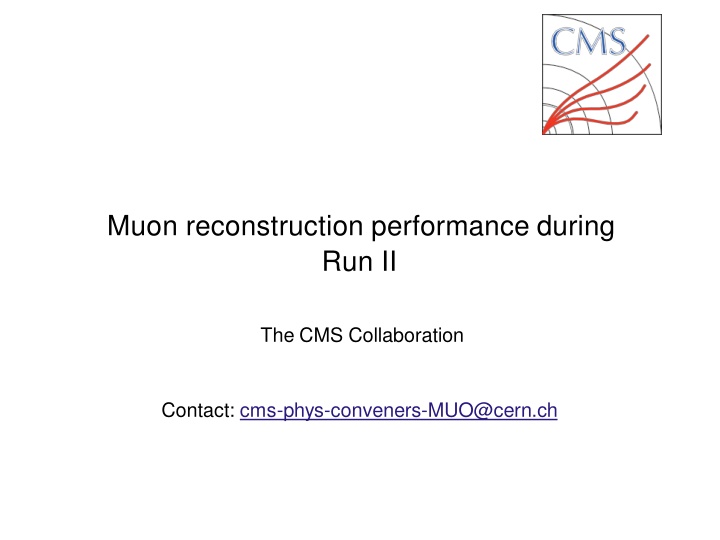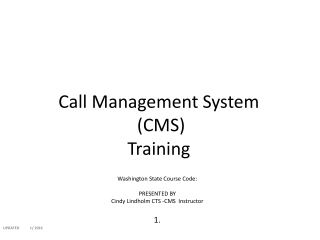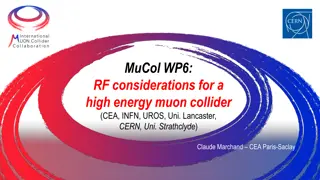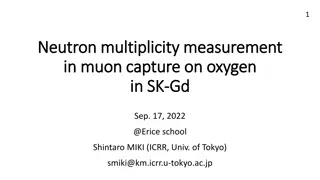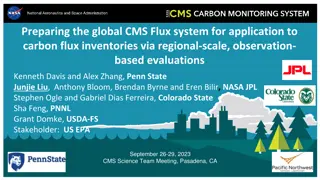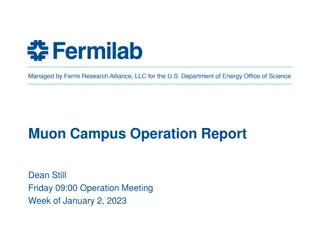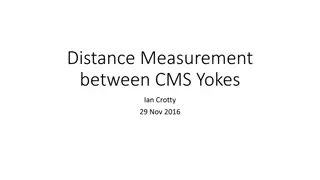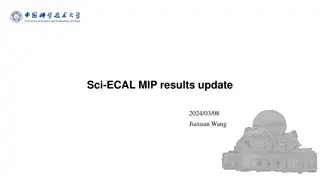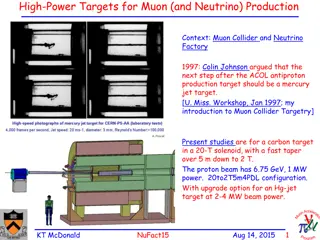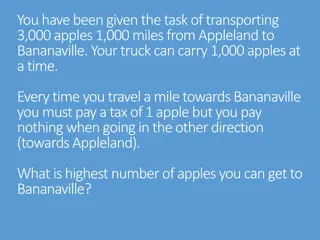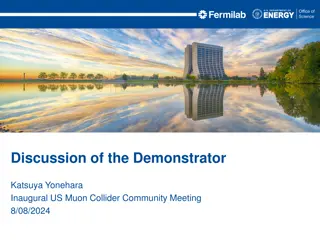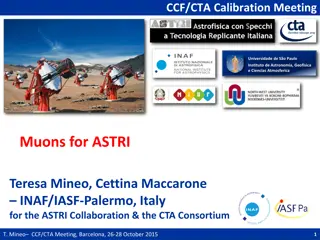Muon Reconstruction Performance in Run II by CMS Collaboration
Insights into muon reconstruction performance during Run II by the CMS Collaboration using tag-and-probe method for efficiency calculations and Z+ events for resolution inference. Details include muon identification, methods, tag-and-probe parameters, and resolution measurements.
Download Presentation

Please find below an Image/Link to download the presentation.
The content on the website is provided AS IS for your information and personal use only. It may not be sold, licensed, or shared on other websites without obtaining consent from the author.If you encounter any issues during the download, it is possible that the publisher has removed the file from their server.
You are allowed to download the files provided on this website for personal or commercial use, subject to the condition that they are used lawfully. All files are the property of their respective owners.
The content on the website is provided AS IS for your information and personal use only. It may not be sold, licensed, or shared on other websites without obtaining consent from the author.
E N D
Presentation Transcript
Muon reconstruction performance during Run II The CMS Collaboration Contact: cms-phys-conveners-MUO@cern.ch
METHODS AND SAMPLES Methods: ) Efficiencies are calculated using the tag-and-probe method exploiting the Z + resonance ) Resolution is inferred by evaluating the features of the + invariant mass distribution in the Z mass peak Data: ) Proton-proton collision data at s = 13 TeV, corresponding toan integrated luminosity of 41.3 fb 1 (2017), and 59.8 fb 1(2018) ) Events collected using single muon triggers Monte Carlo simulations: ) Drell-Yan + jets LO sample(madgraph) ) Events are weighted to match the pile-up distribution of data Page2
MUON IDENTIFICATION (ID) More details can be found in JINST 13 (2018) no.06, P06015 ) Loose muon ID: aims to identify prompt muons originating at the primary vertex, and muons from light and heavy flavor decays, as well as maintain a low rate of the misidentification of charged hadrons as muons. A loose muon is a muon selected by the PF algorithm that is also either a tracker or a global muon. ) Tight muon ID: aims to suppress muons from decay in flight and from hadronic punch-through. A tight muon is a loose muon with a tracker track that uses hits from at least six layers of the inner tracker including at least one pixel hit. The muon must be reconstructed as both a tracker muon and a global muon. The tracker muon must have segment matching in at least two of the muon stations. The global muon fit must have 2/ndof < 10 and include at least one hit from the muon system. A tight muon must be compatible with the primary vertex, having a transverse impact parameter smaller than 0.2 cm and a longitudinal impact parameter smaller than 0.5 cm Page3
TAG-AND-PROBE PARAMETERS ) Tag-and-probe method is used to extract efficiencies in Z + events ) The invariantmass distribution for signal and background is fitted using the following functions: ) signal: sum of 2 Voigtians ) background: error function with an additional multiplicative exponential term at high m + ) Mass window: [70-130]GeV ) Tag selection in 2017(2018): ) Tight ID muon with pT >29 (26) GeV ) Tight PF isolation ) Matched with single isolated trigger ) Probeselection: ) Tracker muons with pT > 20 GeV The plots shown include only statistical uncertainties. Quoted systematic uncertainties are estimated varying the isolation cut on the tag muon, with variations of the signal and background pdfs, and enlarging and reducing the mass window. Page4
RESOLUTION MEASUREMENT ) Muon scale resolution are measured in the Z + mass resonance ) Di-muon events are required to have two muons passing the tight ID and isolation criteria ) m + distribution is fitted to a Gaussian function convolvedwith the convolution of a Breit-Wigner and a Crystal-Ball ) Mean and standard deviation areevaluated ) Muons have been calibrated using the Rochestermethod ) More information in EPJC V72, 10.2194 (2012) ) Uncertainties include systematic and statisticalcomponents Page5
LOOSE ID EFFICIENCIES VS pT , 59.8 fb-1 (13 TeV,2018) 59.8 fb-1 (13 TeV,2018) 1.1 1.1 Efficiency Efficiency CMS CMS Loose Id, p 20 GeV Loose Id, | | < 2.4 T 1.05 PreliminaryData 1.05 PreliminaryData MC MC 1 1 0.95 0.95 0.9 0.9 0.85 0.85 0.8 1.04 1.02 0.8 1.04 1.02 Ratio Ratio 1 1 0.98 0.96 0.98 0.96 20 40 60 80 100 120 140 160 180 200 2 1.5 1 0.5 0 0.5 1 1.5 2 Muon p [GeV] Muon T Loose lepton ID efficiency as a function of and pT for 2018 data and MC. The denominator is tracker muons with pT > 20 GeV. No dependency with respect to the number of primary vertices was observed. Average scale factor is 0.998. Systematic uncertainties are smaller than < 0.2%. Page7
TIGHT ID EFFICIENCIES VS pT , 59.8 fb-1 (13 TeV,2018) 59.8 fb-1 (13 TeV,2018) 1.1 1.1 Efficiency Efficiency CMS CMS Tight Id, p 20 GeV Tight Id, | | < 2.4 T 1.05 PreliminaryData 1.05 PreliminaryData MC MC 1 1 0.95 0.95 0.9 0.9 0.85 0.85 0.8 1.04 1.02 0.8 1.04 1.02 Ratio Ratio 1 1 0.98 0.96 0.98 0.96 20 40 60 80 100 120 140 160 180 200 2 1.5 1 0.5 0 0.5 1 1.5 2 Muon p [GeV] Muon T Tight lepton ID efficiency as a function of and pT for 2018 data and MC. The denominator is tracker muons with pT > 20 GeV. No dependency with respect to the number of primary vertices was observed. Average scale factor is 0.98. Systematic uncertainties are smaller than < 0.5%. Page8
Muon resolution in Run 2 Page9
MUON RESOLUTION IN 2018 59.76 fb-1 (2018, 13 TeV) 106 CMS Preliminary Data Z / Background 1.5 59.76 fb-1 (2018, 13TeV) 92.5 Uncorrected CMS Data MC Uncertainty 92Preliminary (GeV) 1 m 91.5 Resolution measured in Z + events in the 2018 dataset. Top and bottom left plots show the mean and the standard deviation of the m + resonance peak obtained fitting the distribution to the convolution of a Gaussian with a Breit-Wigner and a Crystal-Ball. Uncertainties incorporate systematic uncertainties from the Rochester method. 0.5 91 90.5 90 Data /MC 1.1 Data / MC 1.002 1 1 0.9 0.998 85 90 95 100 0 1 2 2 1 m (GeV) lead 59.76 fb-1 (2018, 13TeV) 106 59.76 fb-1 (2018, 13TeV) 4 CMS Preliminary Data Z / Background (GeV) Data MC Uncertainty CMS Preliminary 1.5 3 Corrected 1 2 1 0.5 0 Data / MC 1.1 Data /MC 1.1 1 0.9 1 0 1 2 2 1 0.9 lead 85 90 95 100 m (GeV) Plots in the right shows the data / Monte Carlo comparison of the m + distribution before (top) and after (bottom) applying the scale corrections given by the Rochester method. Page10
ENERGY SCALE IN HIGH ENERGY MUONS ) Energy scale corrections for high energy muons are estimated using events with two muons with pT > 200 GeV, using the Generalized Endpoint method (JINST 13 (2018) P06015) ) Custom identification and momentum assignment criteria are applied to the muon candidates, described in JINST 13 (2018) P06015 41.3 fb-1(2017) Additive b[c/TeV] 41.3 fb-1(2017) 0.8CMS 0.6Preliminary Events CMS -180< <-60 10 Preliminary 4 -60< <60 103 0.4 60< <180 102 0.2 10 Data 0 DY 1 top diboson 10 1 0.2 MC Uncertainty 10 2 0.4 1.4 1.2 TuneP Data/MC 0.6 1 0.8 0.6 0.8 2 1.5 1 0.5 0 0.5 1 1.5 2 5 4 3 2 1 0 1 2 3 4 5 Q/p (1/TeV) T (Left) Distribution of muon curvature in data and Monte Carlo in Z + events. (Right) additive correction to the muon curvature ( + b ) as a function of and . b isinjected as an additive correction to curvature in Monte Carlo simulations, and its value is chosen such that the 2 of the comparison between data and Monte Carlo is minimized. Additive corrections are consistent with those obtained with the Rochester method. Page11
